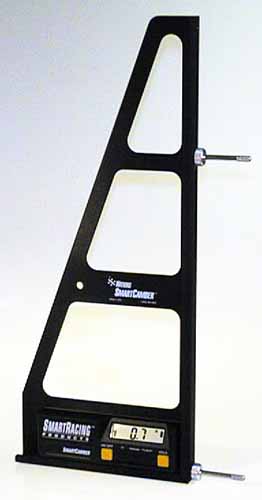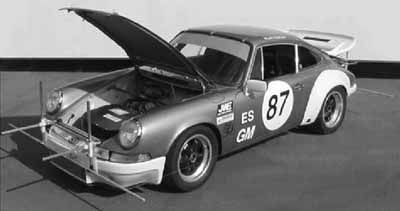OK,
I'm working on a home alignment on my teener, and am trying to calculate my camber adjustments. I can't use the bird board measurements because I'm running 18" wheels. So, in order to get an adjustment measurement, I calculated the circumference of my wheels--outer lip to outer lip (this is where I take my measurements). C=diameter x pi--right? So if my wheels measure 19.5", then the circumference = 19.5 x 3.14159 which gives a circumference of 61.26". If you divide the circumference by 360, then 1 degree = .17". In order to run 30" of negative camber, I divide by three again to give me .05" or 1.43mm. Now, in order to achieve that number, I must multipy by two to get the actual measurement from the bottom of the rim to the top of the rim, right? Long story short, my measurement needs to be 2.86 (call it 3mm) greater at the top of the rim than the bottom of the rim, right? I'm a cop, not a math genius, so you engineers feel free to chime in.... thanks tons!!!!!
While on the subject of alignments.... What should the toe in measurements be in degrees? Am I right that a 32nd on 15's is different than a 32nd on 18's?
--jaybird
Full Version: alignment math
I am assuming you mean -3 degrees camber, but if not you can just change the numbers
I haven't read the bird board instructions, but in to start you off this page is very informative on tire alignments.
http://www.tirerack.com/tires/tiretech/techpage.jsp?techid=4
Now, going by what they have written you can use geometry to figure out the necessary difference. All you need to do is find the wheel radius which equals the wheel diameter / 2 (since the degree measure is from the imaginary central axis of the wheel perpendicular to ground and to the new central axis). Then you can use trig and do sin(3)*wheel radius = distance from imaginary center axis to new central axis.
To simplify this measurement you can measure the horizontal difference from the bottom of the rim to the top of the rim. All you need to do is double the distance difference I came up with
Using sin(3)*wheel radius (with your radius as 19.5/2 = 9.75) the horizontal difference from wheel center to top edge is .510 inches.
If you want to measure the horizontal difference from the bottom to top of rim you need .510*2 = 1.02 inches.
I added a quickly drawn picture to illustrate the geometry.
I haven't read the bird board instructions, but in to start you off this page is very informative on tire alignments.
http://www.tirerack.com/tires/tiretech/techpage.jsp?techid=4
Now, going by what they have written you can use geometry to figure out the necessary difference. All you need to do is find the wheel radius which equals the wheel diameter / 2 (since the degree measure is from the imaginary central axis of the wheel perpendicular to ground and to the new central axis). Then you can use trig and do sin(3)*wheel radius = distance from imaginary center axis to new central axis.
To simplify this measurement you can measure the horizontal difference from the bottom of the rim to the top of the rim. All you need to do is double the distance difference I came up with
Using sin(3)*wheel radius (with your radius as 19.5/2 = 9.75) the horizontal difference from wheel center to top edge is .510 inches.
If you want to measure the horizontal difference from the bottom to top of rim you need .510*2 = 1.02 inches.
I added a quickly drawn picture to illustrate the geometry.
get a camber gauge ... 
http://www.pegasusautoracing.com/productde...iorb=4764&0
they are adjustable for any wheel diameter and work great. takes all the guesswork out of adjusting your camber.
btw. -3 camber seems a bit much ...
 Andy
Andy

http://www.pegasusautoracing.com/productde...iorb=4764&0
they are adjustable for any wheel diameter and work great. takes all the guesswork out of adjusting your camber.
btw. -3 camber seems a bit much ...

and for the toe, just use strings and don't worry about degrees, just measure the difference in mm from the front of the rim to the back of the rim ...
http://www.pegasusautoracing.com/productde....asp?RecId=3004
![popcorn[1].gif](http://www.914world.com/bbs2/style_emoticons/default/popcorn[1].gif) Andy
Andy

http://www.pegasusautoracing.com/productde....asp?RecId=3004

I agree on -3 being excessive... that was what Jim D. used for his calculations. I'm actually shooting for 30 min of negative camber (one third of a degree). It's a street application... If I weren't a CSOB, I'd buy the pegasus goodies... 8^)
--jaybird
--jaybird
I bought one of these, it's only $40.00. http://www.racerpartswholesale.com/product...r_Camber_Gauges
It's not nearly as easy to use as the $200.00 units, but it works.
For measuring toe, I spin the tires, make a line with chalk on the tread, scribe a line in the chalk with a sharp screwdriver, and measure between the scribed lines on the front and rear of each tire after I let the car down and bounce/roll it.
It's not nearly as easy to use as the $200.00 units, but it works.
For measuring toe, I spin the tires, make a line with chalk on the tread, scribe a line in the chalk with a sharp screwdriver, and measure between the scribed lines on the front and rear of each tire after I let the car down and bounce/roll it.
I agree on -3 being excessive... that was what Jim D. used for his calculations. I'm actually shooting for 30 min of negative camber (one third of a degree). It's a street application... If I weren't a CSOB, I'd buy the pegasus goodies... 8^)
--jaybird
Oops, my mistake. I thought that seemed excessive
For 1/3 degree the number is .057 (instead of .51) which is about 1/16 of an inch. So the horizontal difference from bottom to top would come out to about an 1/8 on an inch.
I agree on -3 being excessive... that was what Jim D. used for his calculations. I'm actually shooting for 30 min of negative camber (one third of a degree). It's a street application... If I weren't a CSOB, I'd buy the pegasus goodies... 8^)
--jaybird
Oops, my mistake. I thought that seemed excessive
For 1/3 degree the number is .057 (instead of .51) which is about 1/16 of an inch. So the horizontal difference from bottom to top would come out to about an 1/8 on an inch.
Cool,
Looks like my math was right, I just went through a couple of extra steps. It's only been 21 years since my last college trig or geometry class...
Thanks!!!!!
--jaybird
Still, all that math will drive you bonkers!!!
Follow Andy's advice....he nailed it.
Follow Andy's advice....he nailed it.
Um, there are 60 minutes per degree. if you are shooting for 30 minutes, you are looking for 1/2" degree.
20 minutes would be 1/3 degree.
60 seconds in a minute, 60 minutes in a degree.
Just thought you should know.
I think your basic theory (spelled out above) looks good, but I didn't check any of your actual calculations. It's too late in the day for me to do math.....
John
20 minutes would be 1/3 degree.
60 seconds in a minute, 60 minutes in a degree.
Just thought you should know.
I think your basic theory (spelled out above) looks good, but I didn't check any of your actual calculations. It's too late in the day for me to do math.....
John
Um, there are 60 minutes per degree. if you are shooting for 30 minutes, you are looking for 1/2" degree.
20 minutes would be 1/3 degree.
60 seconds in a minute, 60 minutes in a degree.
Just thought you should know.
I think your basic theory (spelled out above) looks good, but I didn't check any of your actual calculations. It's too late in the day for me to do math.....
John
DOH!!!
This thread hurts my head........
how funny... I just put 3deg neg camber and 1/8" toe in the rear yesterday with a laser pointer and a tape measure/simple angle finder. It works just as well as any camber gauge I have ever used frankly and cost me less than $20 IIRC. Key is to have a level floor when you do this stuff.
I set the camber to where I want it with the angle finder and a flat sheet of alum across the tire. Then when I want to set the toe, I use a laser. I shoot the plane with the laser and with a tape measure I get the plane parallel to the chassis of the car. Then I simply measure the front and rear of the tire 13" up from the ground to get toe. I set the rear at 1/8" toe-in by setting one tire to 1/16" with the laser, then use toe plates to set the other side cuz it is easier to match them to each other than futz with the laser a second time.
It is important to either go thru all the pain of strings or just use a laser on at least one side (I can have that laser set up in under 15 minutes) to get one side square to the car itself. The other side just needs to be toed relative to the other side.
If you try to set camber with a tape measure against the tire, you need to understand the bottom of the tire bulges out under the weight of the car, so your measurement will be bogus and you will have less camber than you thought because you measured the bottom out further than it really is.
I set the camber to where I want it with the angle finder and a flat sheet of alum across the tire. Then when I want to set the toe, I use a laser. I shoot the plane with the laser and with a tape measure I get the plane parallel to the chassis of the car. Then I simply measure the front and rear of the tire 13" up from the ground to get toe. I set the rear at 1/8" toe-in by setting one tire to 1/16" with the laser, then use toe plates to set the other side cuz it is easier to match them to each other than futz with the laser a second time.
It is important to either go thru all the pain of strings or just use a laser on at least one side (I can have that laser set up in under 15 minutes) to get one side square to the car itself. The other side just needs to be toed relative to the other side.
If you try to set camber with a tape measure against the tire, you need to understand the bottom of the tire bulges out under the weight of the car, so your measurement will be bogus and you will have less camber than you thought because you measured the bottom out further than it really is.
This is a "lo-fi" version of our main content. To view the full version with more information, formatting and images, please click here.
